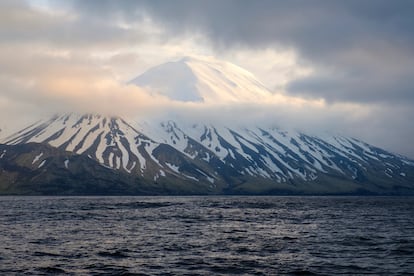Swarm of quakes at Alaska volcano could mean eruption coming
The last known eruption for Tanaga was in 1914. It erupted twice in the late 1700s and again in 1829

A swarm of earthquakes occurring over the past few weeks has intensified at a remote Alaska volcano dormant for over a century, a possible indication of an impending eruption. The Alaska Volcano Observatory raised the alert level to advisory status for Tanaga Volcano late Tuesday after the quakes became very vigorous.
“We started seeing a whole lot of earthquakes occurring, one after the other, several per minute,” said John Power, a research geophysicist with the US Geological Survey stationed in Anchorage at the Alaska Volcano Observatory.
There have been hundreds of small earthquakes, none larger than magnitude 2.75, but they are concentrated beneath the summit of the volcano, he said.
“That indicates that we’re seeing significant unrest at the volcano,” Power said.
“Whether or not this will lead to an eruption is something we can’t say at this point in time,” he said. “But we are concerned about it enough that we have gone and elevated the warning level.”
While the increase causes concern, he said many times earthquake activity will drop off with no eruption.
“It’s anybody’s guess as to where this particular round of earthquake activity may end up,” he said.
The volcano is on an uninhabited island in the western Aleutians, about 1,250 miles (2,012 kilometers) southwest of Anchorage. There are no communities or structures there, but Adak, a city of about 170 residents on another island, is about 65 miles (105 kilometers) away and could see ashfall.
If the volcano were to erupt, the biggest threat would be to aircraft. The Aleutians are below the routes that jets fly between North America and Asia. Volcanic ash is angular and sharp and can cause an airplane engine to shut down. Previous eruptions had both ash clouds and viscous lava that moves very slowly away from the mountain, much like what happened at Mount St. Helens in Washington state in 1980.
“It’s very different than what you would see, for example, in Hawaii, Kilauea or Mauna Loa, where you see these beautiful red rivers of lava flowing down the side of the volcano,” Power said.
Tanaga is actually part of a three-volcano complex on the island. It’s the tallest of the three at 5,925 feet (1,806 meters). It sits in the middle, with Sajaka, a 4,443-foot volcano to its west. Sajaka had an older cone that collapsed into the North Pacific Ocean with a new cone that has emerged.
To the east of Tanaga is Takawangha, a 4,75-foot (1,449-meter) volcano that is mostly ice-covered except for four craters, the Alaska Volcano Observatory says.
The last known eruption of Tanaga was in 1914. It erupted twice in the late 1700s and again in 1829.
The observatory in a release said there are no known eruptions of Takawangha or Sajaka. However, field work has indicated that eruptions may have occurred from those volcanos and were attributed to Tanaga.
Sign up for our weekly newsletter to get more English-language news coverage from EL PAÍS USA Edition
Tu suscripción se está usando en otro dispositivo
¿Quieres añadir otro usuario a tu suscripción?
Si continúas leyendo en este dispositivo, no se podrá leer en el otro.
FlechaTu suscripción se está usando en otro dispositivo y solo puedes acceder a EL PAÍS desde un dispositivo a la vez.
Si quieres compartir tu cuenta, cambia tu suscripción a la modalidad Premium, así podrás añadir otro usuario. Cada uno accederá con su propia cuenta de email, lo que os permitirá personalizar vuestra experiencia en EL PAÍS.
¿Tienes una suscripción de empresa? Accede aquí para contratar más cuentas.
En el caso de no saber quién está usando tu cuenta, te recomendamos cambiar tu contraseña aquí.
Si decides continuar compartiendo tu cuenta, este mensaje se mostrará en tu dispositivo y en el de la otra persona que está usando tu cuenta de forma indefinida, afectando a tu experiencia de lectura. Puedes consultar aquí los términos y condiciones de la suscripción digital.
More information

TikTok campaign targets Biden on proposed Alaska oil project
Archived In
Últimas noticias
Trump claims peace in Ukraine is near, but Moscow suggests otherwise
A survivor’s account of the Interoceanic Train accident: ‘We were scared because of the speed on the curve’
The Interoceanic Train, the Mexican alternative to the Panama Canal
What is known about the Interoceanic Train derailment in Oaxaca
Most viewed
- Oona Chaplin: ‘I told James Cameron that I was living in a treehouse and starting a permaculture project with a friend’
- Reinhard Genzel, Nobel laureate in physics: ‘One-minute videos will never give you the truth’
- Why the price of coffee has skyrocketed: from Brazilian plantations to specialty coffee houses
- Pablo Escobar’s hippos: A serious environmental problem, 40 years on
- Chevy Chase, the beloved comedian who was a monster off camera: ‘Not everyone hated him, just the people who’ve worked with him’









































